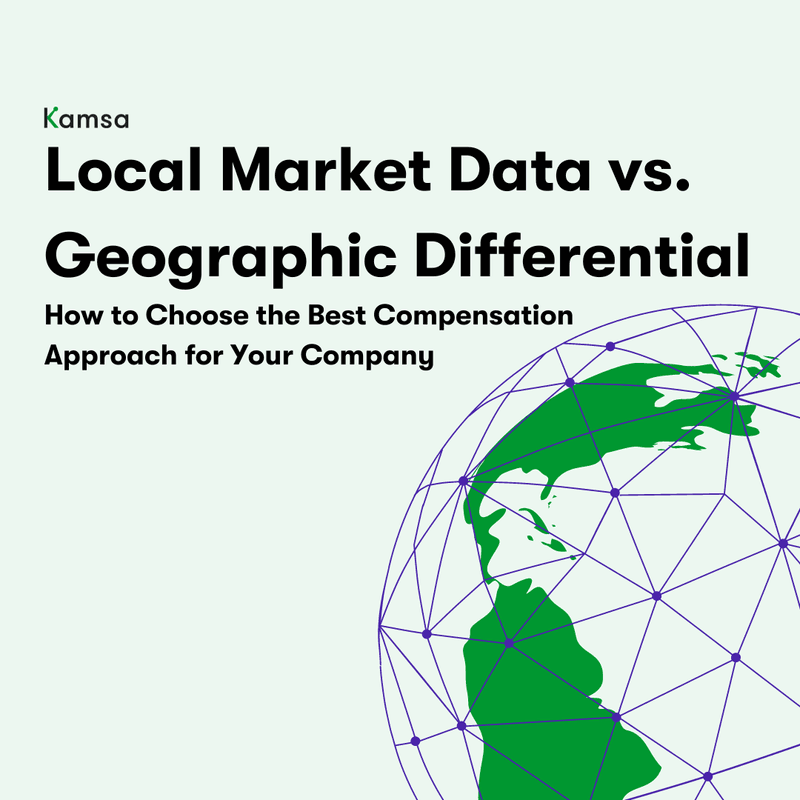
Choosing the Best Compensation Approach for Your Company: Local Market Data vs. Geographic Differential
In developing or updating a compensation structure that aligns with your organization's latest needs, selecting the appropriate market data cut approach is critical to match the pool of talent you recruit from.
What is a Market Data Cut?
A market data cut refers to a specific subset of market compensation data filtered by certain criteria, such as geography or work location. Companies select certain market data cut approaches to use to build salary ranges and benchmark their employees to ensure pay fairness and competitiveness.
Below are two common market data cut approaches to choose from that ensure what you pay employees help retain and attract the global workforce you need to achieve business goals.
Local Market Data Approach
If you plan to maintain a workforce limited to a select few countries or work locations, using the local market data approach is recommended as your organization's default method to develop salary ranges. This method allows you to match an employee's work location to the specific market aligned to that same geographic location and respective cost of labor and cost of living.
🔷 Example 1: An employee within 60 miles of New York City is matched to the New York City market data cut
🔶 Example 2: An employee in London, UK, is matched to the UK - Inner London market data cut
This local market approach ensures that your compensation structure is fine-tuned to the specific market conditions where your employee is based.
Geographic Differential Approach
If your company has a globally distributed workforce, the geographic differential approach is recommended when establishing your salary bands. The geographic differential percentage guideline for each country and or geographic area represents a percentage of the U.S. national average data and factors in the cost of living and cost of labor data by country.
🔷 Example 1: Employees who live within a 60-mile radius of San Francisco use 115% of the U.S. national average as the market data cut
🔶 Example 2: Employees in the London, UK, align with 90% of the US national average
For employees located in the United States, using a three-tiered geographic differentials (see below) is simple and scalable to use:
If the majority of your workforce is located in the U.S., using the geographic differential as the default market data cut approach allows the organization to align with the diverse cost of labor and cost of living across the country, as well as enhance consistency with pay decisions.
The above recommendations apply to roles below the executive level. For executive jobs (e.g., VP level and above), consider using a revenue cut range applicable to your organization, where available, since when you hire executives it’s from a broader geographic area and the revenue size better aligns with the scope and experience level required for similar-sized organizations.
Choosing the right market data cut approach ensures the following:
- Accuracy: Makes sure salary benchmarks are relevant to the specific job market, making compensation packages more competitive and fair.
- Consistency: Allows for a consistent and therefore more fair approach for establishing and aligning salaries with market standards.
- Attraction and Retention: Competitive salary ranges attract top talent and help retain employees by offering market-aligned compensation.
- Budget Management: Assists in managing and planning for compensation budgets effectively (i.e., avoiding over paying or under paying.
Need help figuring out how to pay your employees around the world? Kamsa's compensation experts have your back. We'll help establish the best pay approach and strategy to optimally align with your global workforce.
About Kamsa
Kamsa, founded by compensation thought leader Lola Han, is dedicated to revolutionizing compensation processes. We combine cutting-edge technology with perspectives from compensation experts to help organizations manage employee pay effectively and equitably. Over 500 companies have entrusted Kamsa with the responsibility of simplifying compensation, globally!.
Contact us to enhance the decision-making process within your organization so managers are empowered with data-driven insights.


